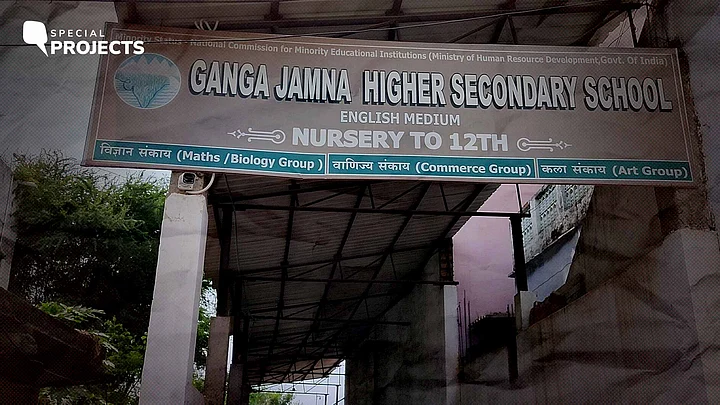This article is part of our ongoing coverage from Madhya Pradesh's Damoh, where the shutting down of English-medium Ganga Jamna School, following a hijab row, has put the future of more than 1,000 children in jeopardy. As we continue to bring you ground reports from Damoh, we need your help.
Become a member – and support our journalism.
Located in the Futera area of Madhya Pradesh's Damoh, Ganga Jamna School came up in 2010, accompanying a change in the area, which was once gripped with violence and crime, locals tells The Quint.
Futera is home to around 15,000 voters and is cramped with houses built in a haphazard way, leaving barely an inch between them. The mohalla is intra-connected with narrow passages, except for one wide road that passes through the front of the school.
The houses are predominantly occupied by lower middle-class families – Muslims, Hindus, and also Jains – with most of them being farmhands, beedi-makers, or labourers.
A local social worker, Narmada Singh Ekta, tells The Quint, that the school grew popular as it provided quality education to students, especially those from marginalised communities, and helped get rid of 'goons' from the area.
"Before the school was established in Futera, this area was known for its criminal activities. People feared travelling through this area post-sunset. But after the school opened, the situation changed. Those who were involved in criminal activities had children of their relatives or neighbours going to the school, and so they stopped coming here."Narmada Singh Ekta
However, nearly 13 years after its establishment, the school stands shut amid allegations of religious conversion and 'forcing' Hindu students to wear the hijab.
Where Do Kids of Lower Middle-Class Families Go?
Vikram Thakur's three children were studying in Ganga Jamna School. A farmer by profession, he owns five acres of land – and lives merely 700 metres from the school. He caters to the needs of his family of five from the earnings from his land.
Thakur's worry right now is finding a new school for his children. But, more so, being able to afford it.
"My three children were studying in Ganga Jamna School while I only had to pay the fees for two of my kids. They had exempted the fees for one of my children. If the school doesn't open, I don't know where my kids would be."Vikram Thakur
Talking about finding a new school, he says:
"I was paying Rs 20,000 for the education of all of the children and they were getting the books and dresses for free from the school. We didn't incur transportation fees as the school is within walking distance. Since the school was shut down, I visited some of the English medium schools but they are charging more fees than I can afford. I also begged them for fee exemption but to no avail. What should I do?"
Tarun – now a Class 10 student at the Ganga Jamna School – has studied in Ganga Jamna School since nursery. His father Mukesh Ahirwar is a contractual employee with the Madhya Pradesh Electricity Board and earns Rs 8,000-9,000 per month. His mother is a homemaker.
"I want to become a sub-inspector in the police but before that, I need to pass Class 10. They have closed our school, and my father won't be able to sustain the expenses of other schools as they charge more and the government school doesn't provide as good an education as Ganga Jamna."Tarun
Tarun's mother Usha Ahirwar tells The Quint that they had paid the first instalment of Tarun's fees for Class 10 – and they don't have the means to get him admitted to a new school.
"We had paid Rs 7,000 for Tarun's Class 10. Now, you tell me, how will we pay for his admission to a new school and then for his fees and uniform? The entire episode has only harmed the students and kids. Those crying foul, would they pay for my son's education?"
How Will the School Build Trust Again?
A local Bharatiya Janata Party (BJP) leader, who did not want to be named, blames the media for 'tainting' the school, but wonders whether the trust of all parents can be restored.
"The school became the fodder for the media, for the right-wing organisations, but the trust of parents has been shaken. Not all members of a society, of a community or a mohalla think likewise. I'm getting calls from parents, worried for their children's education, but also talking about the hijab issue. This incident has introduced a tension that wasn't there in Damoh."BJP leader
Some of the parents that this reporter met were candid about not readmitting their children to Ganga Jamna School even if it reopens.
"We are facing challenges in admitting our children to a new school, but we are unsure if we can now send our kids to Ganga Jamna. If there is even a slightest of chance that the school was trying to influence our children's religious beliefs, we can't send them there," a parent, who wanted to stay anonymous, tells The Quint.
Damoh has around 25 government-run primary-middle-high schools catering to 8,000 students while around 40,000 students are getting educated in around 50 private schools in the district.
Damoh District collector Mayank Agarwal tells The Quint that they are mapping the availability of the schools in the area to see if the students of Ganga Jamna can be admitted in some of these schools.
"We are mapping the students and the availability in other schools where these children could be admitted to. However, it's not a one-day process. Our first and foremost concern is about the education of the children and we are trying to sort things out soon."
Until then, 1,200 students are out of school.
(with inputs from Imtiyaz Chishti)
